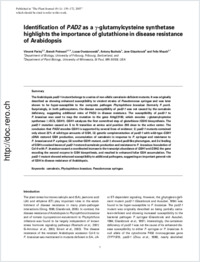Identification of PAD2 as a γ-glutamylcysteine synthetase highlights the importance of glutathione in disease resistance of Arabidopsis
- Parisy, Vincent Department of Biology, University of Fribourg, Switzerland
- Poinssot, Benoit Department of Biology, University of Fribourg, Switzerland - UMR Plante Microbe Environnement, Université de Bourgogne, Dijon, France
- Owsianowski, Lucas Department of Biology, University of Fribourg, Switzerland
- Buchala, Antony J. Department of Biology, University of Fribourg, Switzerland
- Glazebrook, Jane Department of Plant Biology, University of Minnesota, St Paul, USA
- Mauch, Felix Department of Biology, University of Fribourg, Switzerland
-
2006
Published in:
- The Plant Journal. - 2007, vol. 49, no. 1, p. 159-172
English
The Arabidopsis pad2-1 mutant belongs to a series of non-allelic camalexin-deficient mutants. It was originally described as showing enhanced susceptibility to virulent strains of Pseudomonas syringae and was later shown to be hyper-susceptible to the oomycete pathogen Phytophthora brassicae (formerly P. porri). Surprisingly, in both pathosystems, the disease susceptibility of pad2-1 was not caused by the camalexin deficiency, suggesting additional roles of PAD2 in disease resistance. The susceptibility of pad2-1 to P. brassicae was used to map the mutation to the gene At4g23100, which encodes γ-glutamylcysteine synthetase (γ-ECS, GSH1). GSH1 catalyzes the first committed step of glutathione (GSH) biosynthesis. The pad2-1 mutation caused an S to N transition at amino acid position 298 close to the active center. The conclusion that PAD2 encodes GSH1 is supported by several lines of evidence: (i) pad2-1 mutants contained only about 22% of wild-type amounts of GSH, (ii) genetic complementation of pad2-1 with wild-type GSH1 cDNA restored GSH production, accumulation of camalexin in response to P. syringae and resistance to P. brassicae and P. syringae, (iii) another GSH1 mutant, cad2-1, showed pad2-like phenotypes, and (iv) feeding of GSH to excised leaves of pad2-1 restored camalexin production and resistance to P. brassicae. Inoculation of Col-0 with P. brassicae caused a coordinated increase in the transcript abundance of GSH1 and GSH2, the gene encoding the second enzyme in GSH biosynthesis, and resulted in enhanced foliar GSH accumulation. The pad2-1 mutant showed enhanced susceptibility to additional pathogens, suggesting an important general role of GSH in disease resistance of Arabidopsis.
- Faculty
- Faculté des sciences et de médecine
- Department
- Département de Biologie
- Language
-
- English
- Classification
- Biological sciences
- License
-
License undefined
- Identifiers
-
- RERO DOC 6306
- DOI 10.1111/j.1365-313X.2006.02938.x
- Persistent URL
- https://folia.unifr.ch/unifr/documents/300191
Statistics
Document views: 167
File downloads:
- pdf: 604
